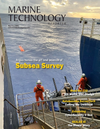
Page 14: of Marine Technology Magazine (May 2024)
Read this page in Pdf, Flash or Html5 edition of May 2024 Marine Technology Magazine
HISTORY DIVING
Image Credit: Scan of personal log, Howard Talkington,
Head, Ocean Technology Branch, NOSC-San Diego.
Figure 2: A portion of a report titled, “SEALAB III Sequence of Events”, compiled by NOSC after the event, likely typed from handwritten logs, is shown. The text notes the shipboard effort to locate an electrical short to ground by isolating various shipboard circuits. They conclude the ground is in either the PTC (Diving
System) or the habitat. At this point in time, both PTCs are on deck, and PTC-1 is being checked off for the next dive. Therefore, the short
Figure 3
Of? cial U.S. Navy photo must be in the habitat.
Aquanaut bought his own 3/8” custom wetsuit;
U.S. Navy Board of Inquiry • The heater in the PTC did not work. The divers are not
A U.S. Navy Board of Inquiry (BOI) was convened. Ulti- mately, the BOI cited carbon dioxide poisoning as the of? cial told, and discover this only when in the PTC; • Helium unscramblers never worked; cause of death, and ? xed sole blame on an enlisted man, Se- • Diver communication systems never worked; nior Chief Torpedoman Paul “P.A.” Wells, a decorated World • Plans for habitat deployment and recovery were unde? ned
War II Marine Corps veteran and fellow diver. That did not set in critical areas, such as the umbilical cable between the habitat well with the Aquanauts.
Bond wrote in his journal, “Not one of us believed that Paul and surface support ship had to be connected during lowering.
Wells would ever load an empty canister into a Mk IX rig,” However, it was delivered on a spool with no slip rings, so it a sentiment repeated by every Aquanaut that has spoken to had to be unspooled and ? aked on deck before lowering; • The plan to open the habitat entry hatch was not worked this author about this topic. Warrant Of? cer Robert A. Barth,
Aquanaut #1, wrote, “We lost two good divers that day, Berry out. Positive interior pressure kept the 4-ft square hatch shut as the diver tried to open it with a crow bar on both dives.
Cannon and Paul Wells.” Aquanaut Andy Pruna, Team 5, said, “P.A. was the most capable guy, the most meticulous. I’d dive Topside had a view of a differential pressure gauge, but failed to comprehend its signi? cance. In between dives, the interior a rig he prepared any day.” pressure fell and the hatch opened itself;
In the fullness of time, dive logs, journals, and reports by those • Critically, power surges and ground-fault alarms on the directly involved in the SEALAB III habitat have come to light. main power cable to the habitat (440VAC, 3f, 152kVA) con- ? rm main electrical shorts to seawater. Topside is aware of the
Problems Abounded
Helium drained heat from divers, garbled speech, leaked hazard before they send the divers down on the second dive. through seals, compromised electronics, hosed up underwater The danger is not communicated to the divers.
cables and split sheathes.
The list goes on.
Several program areas were found lacking:
On the second dive, Berry Cannon, Aquanaut/electronics en- • Senior leadership’s experience, and their trust in those gineer, is electrocuted by 440VAC. He dies outright or suffers who had it;
ESD “Electrical Shock Drowning”. • Contractor Oversight and Quality Conformance (QC); • Breathing systems were never tested at depth. Breathing
Responsibility resistance was high, umbilicals sank, Aquanauts had to con-
Paul “P.A.” Wells had no involvement or responsibility for tinuously press the system by-pass to get gas; any of these problems.
• Training of Aquanauts was never done at depth; • Thermal protective suits were never fully tested or func-
The weight of responsibility rests on those in charge.
tional. On site, there was no hot water for the hot water suits,
Bond stressed, “The Principal Investigator decides where to electrically heated suits were pulled for short circuits, and there were no dry suits with insulating long underwear. One draw the line between acceptable risk and excessive hazard; 14 May/June 2024
MTR #4 (1-17).indd 14 6/2/2024 11:23:46 AM

 13
13

 15
15
